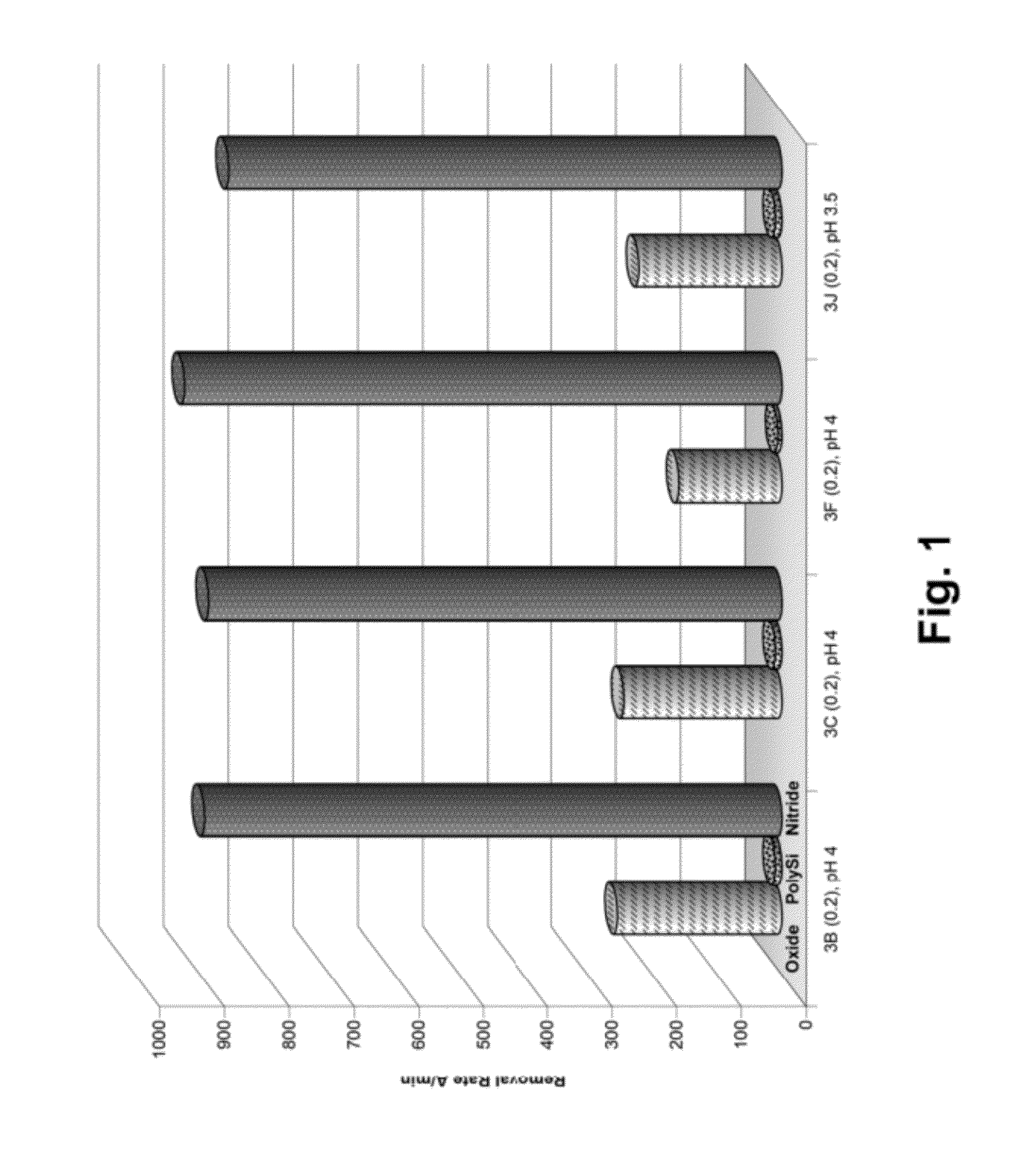Compositions and methods for selective polishing of silicon nitride materials
a technology of silicon nitride and composition, applied in the direction of electrical equipment, chemical equipment and processes, other chemical processes, etc., can solve the problems of poor manufacturing yield, unacceptable polishing rate, and inability to selectively remove insulator materials used in wafer manufacturing
- Summary
- Abstract
- Description
- Claims
- Application Information
AI Technical Summary
Benefits of technology
Problems solved by technology
Method used
Image
Examples
example 1
[0040]This example illustrates the effect of cationic polymers on removal of silicon nitride, polysilicon, and silicon oxide.
[0041]Polishing compositions were used to separately chemically-mechanically polish silicon nitride, silicon oxide, and polysilicon blanket wafers on an Applied Materials REFLEXION® CMP apparatus. Each of the polishing compositions comprised an aqueous slurry of about 0.2 wt % calcined ceria (Advanced Nano Products Co., Ltd., “ANP”, average particle size of about 100 nm), in deionized water at a pH of about 4. Additional components of the CMP compositions are shown in Table 1, in which “Quat” refers to poly(methacryloyloxyethyl trimethylammonium chloride) from Alco Chemical (Alco 4773); 4-PVP refers to poly(4-vinylpyridine); and 2-PVP refers to poly (2-vinylpyridine).
TABLE 1ExampleQuat, ppm4-PVP, ppm2-PVP, ppm1A30001B03001C00301D15300
[0042]Each composition was used to separately polish 300 mm diameter blanket wafers of silicon nitride, polysilicon, and plasma ...
example 2
[0044]Evaluations similar to those in Example 1 were performed on a Mirra polisher. Surprisingly, the observed polysilicon removal rates in the Mirra runs were considerably non-uniform (within wafer), exhibiting areas of very high and very low polysilicon removal. Addition of a polyoxyalkylene polymer, such as a PEG or PEG-PPG-PEG copolymer, surprisingly greatly improved the polysilicon removal uniformity on the Mirra polisher and provided the desired, consistently low, polysilicon removal rates. Compositions comprising various polyoxyalkylene polymers were prepared and evaluated under the following conditions: D100 pad with in situ conditioning as described above, DF of about 3 psi, PS / HS of about 100 / 101 rpm, and a slurry flow rate of about 150 mL / min. Each of the compositions comprised about 0.2 wt % ANP calcined ceria, about 30 ppm of poly(4-vinylpyridine), and about 15 ppm of poly(methacryloyloxyethyl trimethylammonium chloride) at a pH of about 4 in water. The polyoxyalkylene ...
example 3
[0047]Additional aqueous compositions comprising calcined ceria at 0.1, 0.2 and 0.3 wt %, poly(4-vinylpyridine) at 0, 30, 60, and 90 ppm, poly(methacryloyloxyethyl trimethylammonium chloride) (Alco 4773) at 0, 15, and 30 ppm, and PEG-1450 at 0, 800 and 1500 ppm were evaluated by polishing blanket wafers of silicon nitride, polysilicon, and PETEOS on a Mirra polisher (DF of about 3 psi, D100 pad conditioned in situ with a 3M A165 conditioner, PS / HS of about 100 / 101 rpm, slurry flow rate of about 150 mL / min. The formulations of the compositions are shown in Table 4.
TABLE 4Example (wt % Ceria)4-PVP, ppmQuat, ppmPEG, ppm3A (0.2), pH 40003B (0.2), pH 430158003C (0.2), pH 4301515003D (0.2), pH 460158003E (0.2), pH 490158003F (0.2), pH 490308003G (0.1), pH 430158003H (0.1), pH 490308003I (0.3), pH 460158003J (0.2), pH 3.53015800
[0048]Polishing results are provided in Table 5.
TABLE 5OxidePolySiNitrideNitride / PolySiNitride / OxideExampleRRRRRRSelectivitySelectivity3A19713874661.20.23B279169075...
PUM
 Login to View More
Login to View More Abstract
Description
Claims
Application Information
 Login to View More
Login to View More - R&D Engineer
- R&D Manager
- IP Professional
- Industry Leading Data Capabilities
- Powerful AI technology
- Patent DNA Extraction
Browse by: Latest US Patents, China's latest patents, Technical Efficacy Thesaurus, Application Domain, Technology Topic, Popular Technical Reports.
© 2024 PatSnap. All rights reserved.Legal|Privacy policy|Modern Slavery Act Transparency Statement|Sitemap|About US| Contact US: help@patsnap.com








